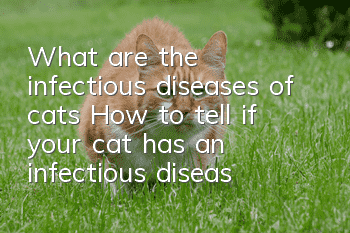What are the infectious diseases of cats? How to tell if your cat has an infectious disease

There are many infectious diseases in cats, the more common ones include feline distemper, feline leukemia, feline rhinotracheitis, etc. In the process of raising cats, many parents do not know how to judge whether cats have infectious diseases. If you want to achieve early detection and early treatment, it is necessary to understand what infectious diseases are in cats.
Feline distemper, a panleukopenia caused by feline parvovirus, is extremely contagious and devastating. The clinical symptoms are anorexia, depression, extremely low spirits, high fever, persistent vomiting, dark brown bloody diarrhea, and finally death due to dehydration and blood loss caused by a sharp decrease in white blood cell count and hemorrhagic enteritis, with a mortality rate of approximately 25-75%.
Feline leukemia is a leukopenia caused by feline leukemia virus; among all infectious vectors in cats, this virus is the most contagious, and the disease can be transmitted even once by contact with a sick cat. The clinical symptoms include weight loss, anemia, fever, gingivitis, diarrhea, etc. However, due to the different degrees, diagnosis is very difficult and must be determined with the help of blood tests.
Feline calicivirus mainly invades the upper respiratory tract of cats, causing bronchial pneumonia or alveolar pneumonia. Clinical symptoms include oral and tongue ulcers, fever, depression, anorexia, sneezing, drooling, increased eye and nasal secretions, pneumonia, etc., which are quite similar to the symptoms of feline rhinotracheitis and are difficult to distinguish clinically.
Feline rhinotracheitis, a highly contagious upper respiratory tract disease caused by feline herpes virus, often occurs in cats. The main clinical symptoms include high fever, depression, coughing, sneezing, eye photophobia, conjunctivitis, and ulcers in the cornea, tongue, mouth and other parts of the body. A large increase in aqueous eye secretions and nasal secretions can be seen, and secondary Bacterial infection can cause secretions to turn into thick mucus.
Feline chlamydia pneumonia, a highly contagious disease caused by Chlamydia psittaci, mainly causes pneumonia in cats. The initial clinical symptom is conjunctivitis, which is later accompanied by fever, severe tearing, and thick eye secretions. Symptoms of rhinitis may also appear, including: increased nasal secretions, sneezing, and thickened nose, etc.; The later clinical symptoms are suppurative pneumonia, which may cause dyspnea and pulmonary edema due to excessive secretions in the trachea and alveoli.
Parents should not be careless after discovering that their pet cats have symptoms similar to the above. The best way is to take the cat to a pet hospital, where a professional veterinarian will examine and diagnose the cat, determine its condition and then treat it accordingly. Note that once a cat is determined to have an infectious disease, it must first be isolated to prevent the disease from harming other healthy cats.
- A cat will die if it urinates for a few days
- Should you deworm yourself or go to a pet store?
- Are cat teasers harmful to cats?
- What should I do if my cat suffers from chronic gingivitis?
- Cat's nails are cracked with a thin layer
- Cats go crazy after eating mutton
- What does cat moss on a cat’s chin look like?
- Can cats reproduce after abdominal transmission is cured?
- What exactly is the sterilization shot for female cats?
- Can I still eat unopened cat food if it has expired?



